Key Takeaways
- Keep your Christmas drink tasting intimate with 6-10 guests for better interaction
- Limit samples to 5-7 different drinks to prevent palate fatigue
- Serve drinks in a specific order: light to heavy, low to high alcohol content
- Pair festive appetizers with complementary drink flavors
- Create a cozy Christmas atmosphere with proper lighting and decorations
- Provide tasting notes and information cards about each beverage
- Include non-alcoholic options for designated drivers and non-drinkers
- Consider transportation options for guests consuming alcohol
The holiday season brings countless opportunities for gathering with loved ones, and a Christmas-themed drink tasting is the perfect way to celebrate the season’s flavors. Whether you’re hosting an intimate gathering or a larger holiday party, a well-planned drink tasting can become the highlight of your festive celebrations.
A Christmas drink tasting isn’t just about sampling beverages—it’s about creating an experience that engages all the senses. From the warm, spicy aromas of mulled wine to the rich, creamy texture of eggnog, every aspect of your tasting should capture the spirit of the holidays. When done right, your guests will remember not only the delicious drinks but also the festive atmosphere and shared moments of holiday cheer.
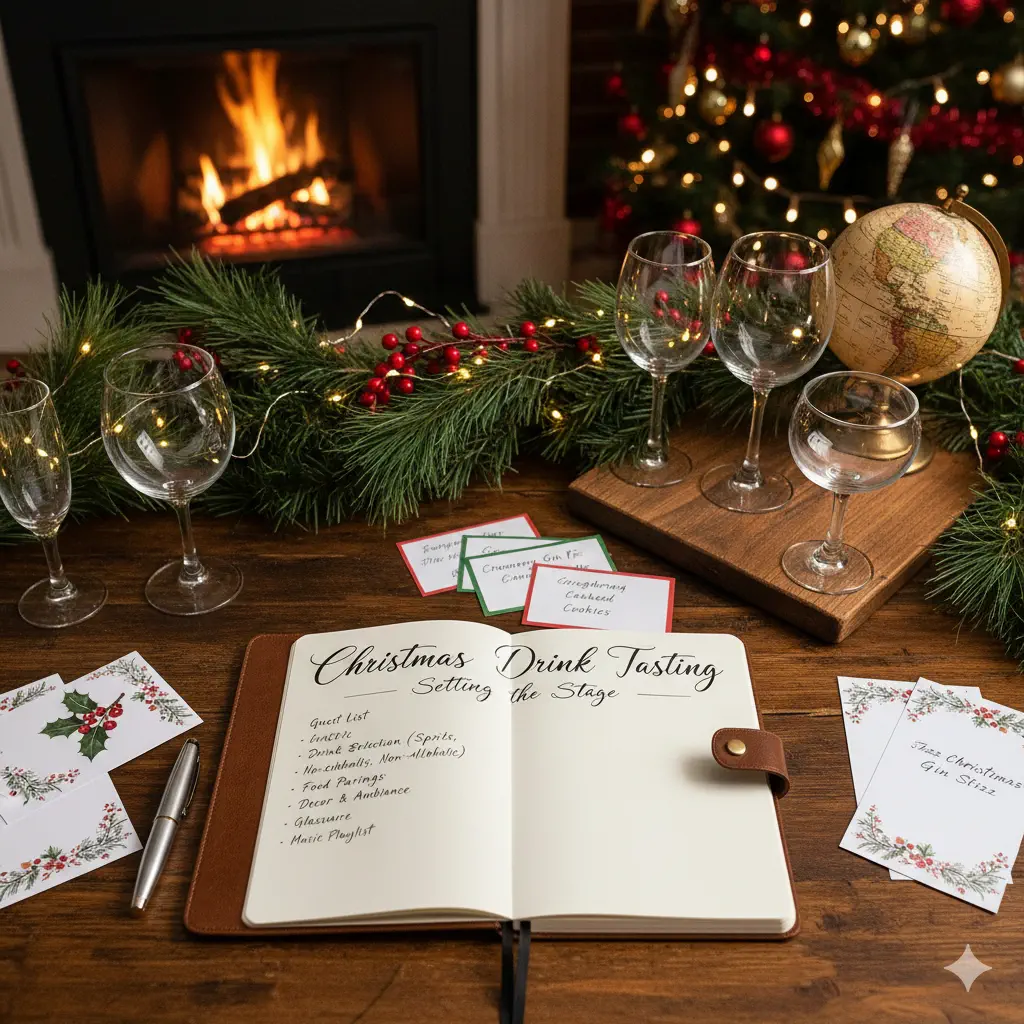
In this guide, we’ll walk you through everything you need to know to host a successful Christmas drink tasting. From planning and preparation to execution and food pairings, we’ve got you covered. By the end of this article, you’ll be ready to create a festive and memorable experience that your guests will talk about well into the new year.
Planning a memorable holiday gathering requires attention to detail, but don’t worry—we’ll break it down into simple steps that will help you create a fun and enjoyable event for both you and your guests.
1. Planning Your Christmas Drink Tasting: Setting the Stage
The key to a successful Christmas drink tasting begins with thoughtful planning. Start by determining your guest list—a smaller gathering of 6-10 people is ideal for a tasting event, as it allows for good conversation and ensures everyone gets to sample each beverage properly. Consider sending invitations 2-3 weeks in advance, as the holiday season tends to fill up quickly with events. Digital invitations work well, but festive paper invitations add a special touch that sets the tone for your event.
When scheduling your tasting, plan for about 2-3 hours for the entire experience. This gives guests enough time to sample each beverage, enjoy the food, and socialize without feeling rushed. A weekend afternoon or early evening works well, allowing guests to fully enjoy the tasting without worrying about early morning commitments the next day. The timing also ensures that natural light is available for seeing the color of beverages before moving to a cozier evening setting.
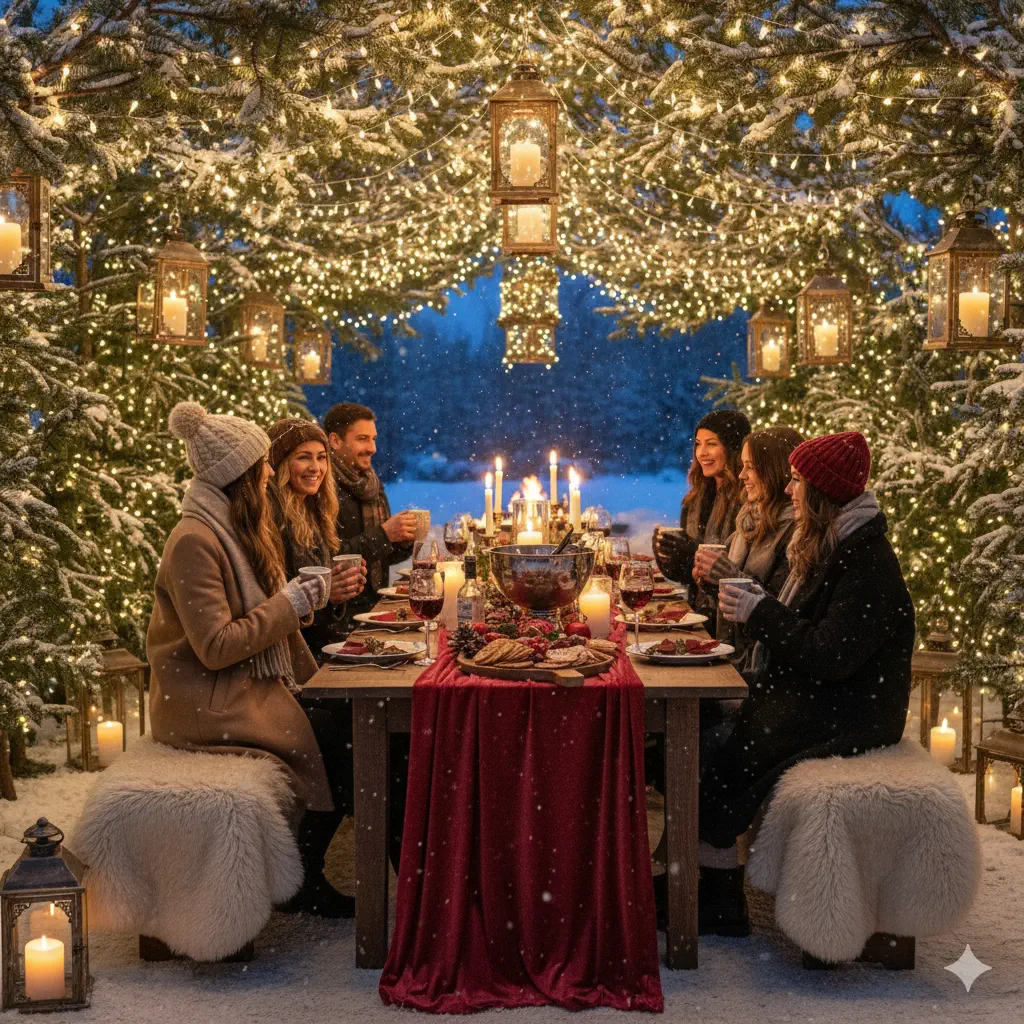
Next, decide on your beverage selection. For a Christmas-themed tasting, consider featuring 5-7 different drinks that showcase holiday flavors. This number is enough to provide variety without overwhelming the palate or leading to excessive drinking. When selecting your beverages, aim for diversity in both flavor profiles and alcohol content to create an interesting progression throughout the tasting. Some festive options include:
- Mulled wine or spiced cider with traditional holiday spices like cinnamon, clove, and star anise
- Winter craft beers (cranberry ales, spiced stouts, winter warmers with notes of vanilla or chocolate)
- Holiday-inspired cocktails (cranberry Moscow mules, peppermint martinis, spiced old fashioneds)
- Aged spirits (whiskey, brandy, or rum with warming characteristics perfect for winter)
- Festive non-alcoholic options (spiced hot chocolate, sparkling cranberry punch, herbal tea blends)
Remember to consider dietary restrictions and preferences when planning your drink menu. Having non-alcoholic alternatives is essential for designated drivers and guests who don’t drink alcohol. These shouldn’t be an afterthought but rather thoughtfully selected options that are just as special and festive as their alcoholic counterparts.
Create a detailed shopping list at least a week before the event, including all beverages, ingredients for mixed drinks, appropriate glassware, and food pairings. This gives you plenty of time to find specialty items that may not be readily available at your local stores. Consider ordering online for unique spirits or seasonal craft beers that could make your tasting experience extra special. Don’t forget to include essentials like ice, garnishes, water pitchers, and palate cleansers in your planning.
2. Setting Up Your Christmas Tasting Space: Creating a Festive Atmosphere
The mood of your tasting space plays a big role in creating a memorable Christmas drink experience. Transform your home into a cozy winter wonderland with thoughtful decorations and good lighting. Soft, warm lighting from string lights, candles (real or battery-operated), and dimmed overhead lights creates an inviting atmosphere that makes the tasting experience better while allowing guests to properly see the colors of each beverage.
Include traditional Christmas decorations like garlands, wreaths, and ornaments, but keep table decorations simple to avoid cluttering the tasting area. A simple centerpiece of pine branches, cinnamon sticks, and cranberries can add festive charm without getting in the way of glassware and tasting notes. Consider using natural elements like evergreen sprigs, pinecones, and holly berries to create an authentic holiday atmosphere that looks and smells great.
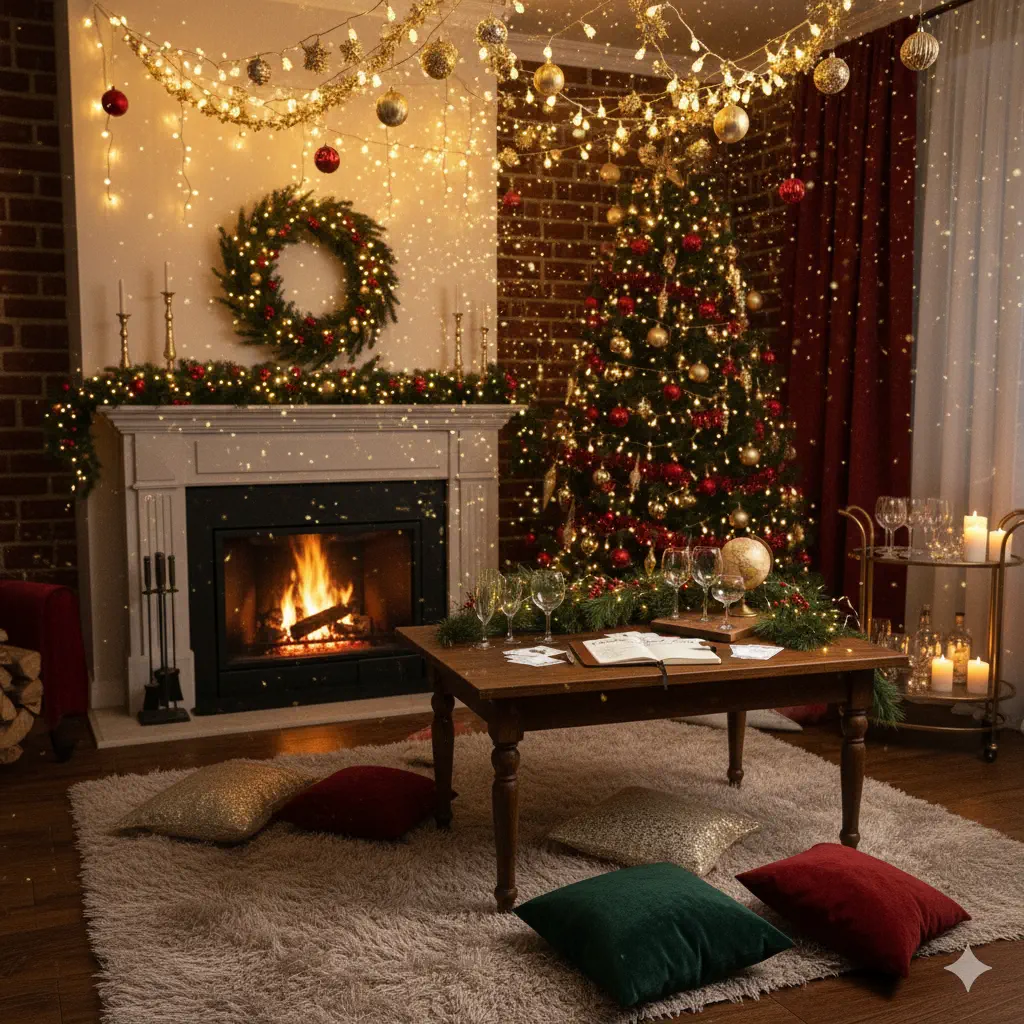
Temperature control is important for a comfortable tasting environment. Keep your space warm but not too hot, as too much heat can affect both the beverages and your guests’ comfort. A temperature between 68-72°F (20-22°C) is generally ideal for most tasting events. This range ensures guests are comfortable while allowing beverages to be served at their best temperatures. Consider the temperature needs of different beverages—mulled wine and hot cocktails should be served warm, while spirits and some cocktails are best slightly chilled.
Set up your tasting station with all necessary supplies:
- Appropriate glassware: Different drinks may require specific glasses to fully appreciate their aromas and flavors. For a Christmas tasting, consider:
- Wine glasses for mulled wine and other wine-based drinks
- Snifters for aged spirits to concentrate aromas
- Mugs for hot beverages (preferably clear glass if you want to showcase colors)
- Cocktail glasses for festive mixed drinks
- Champagne flutes for sparkling beverages
- Tasting tools and accessories:
- Water pitchers and glasses for palate cleansing between samples
- Small plates for food pairings that complement each beverage
- Napkins (preferably cloth for a more elegant feel and sustainable approach)
- Spittoons or dump buckets for guests who prefer not to finish every sample
- Tasting note cards and pens for recording impressions and favorites
- Information displays:
- Create small cards with information about each beverage, including its origin, flavor profile, and interesting facts
- Consider a festive menu board listing the tasting order and progression
- Include recipe cards for any cocktails you’re serving so guests can recreate them at home
- Display books or magazines about holiday beverages for interested guests to browse
Arrange your tasting area to encourage movement and conversation. If space allows, set up separate stations for different beverage categories. This prevents crowding and allows guests to pace themselves through the tasting. Consider creating a central tasting table for guided portions of the event, with smaller stations for self-service exploration. Make sure there are comfortable seating areas nearby for guests to relax between tastings.
Background music can enhance the festive atmosphere—create a playlist of classic Christmas songs or instrumental holiday music at a volume that won’t interfere with conversation. The right soundtrack can make the entire experience better without becoming distracting. Consider music that matches the progression of your tasting, perhaps starting with lighter, brighter tunes and moving to cozier, more relaxed selections as the evening goes on.
3. Selecting Your Christmas Beverages: A Guide to Festive Drinks
Choosing the right selection of Christmas-themed beverages is essential for a successful tasting. Aim for variety in both flavor profiles and alcohol content to appeal to different preferences and create an interesting progression throughout your event. Here’s a guide to selecting beverages that capture the essence of the holiday season and will delight your guests with their festive characteristics:
Traditional Christmas Classics
Start with beverages that have strong traditional ties to the holiday season:
1. Mulled Wine (Glühwein): This warm, spiced wine is a Christmas market staple across Europe. Make your own by simmering red wine with cinnamon sticks, cloves, star anise, orange slices, and a touch of honey or sugar. For an authentic experience, consider using traditional German or Scandinavian recipes. The warming effect of both the temperature and spices makes this a perfect winter beverage that fills your home with an inviting aroma.
2. Eggnog: This rich, creamy drink can be served with or without alcohol (rum, brandy, or whiskey are traditional additions). Consider offering both versions to accommodate all guests. Making homemade eggnog allows you to control the sweetness and richness while using fresh ingredients like vanilla bean, freshly grated nutmeg, and high-quality dairy. The silky texture and complex flavor make this a holiday favorite.
3. Hot Buttered Rum: A comforting blend of rum, brown sugar, butter, and spices like cinnamon and nutmeg creates a decadent winter warmer. The butter creates a velvety mouthfeel, while the spices provide wonderful aromas. Consider preparing the spiced butter mixture in advance, allowing guests to see how a simple spoonful transforms hot water and rum into a luxurious treat.
Craft Beer and Cider Selection
Winter seasonal beers and ciders offer complex flavors that pair wonderfully with holiday foods:
1. Winter Ales: Look for craft beers with notes of caramel, toffee, and spices. Many breweries release special winter editions that include holiday flavors like gingerbread, chocolate, or vanilla. These beers often have a higher alcohol content and maltier profile than their summer counterparts, making them perfect for cold weather sipping and food pairing.
2. Cranberry or Cherry Ciders: These fruit-forward ciders capture holiday flavors and provide a lighter option. The tartness of cranberry or the richness of cherry adds complexity to traditional apple cider. Many craft cideries produce small-batch seasonal releases that showcase local fruit varieties and traditional fermentation methods.
3. Chocolate Stouts: Rich, dark beers with chocolate notes complement the indulgent nature of holiday gatherings. These velvety stouts often feature hints of coffee, vanilla, or even peppermint during the holiday season. Their robust character stands up well to hearty winter foods while providing a dessert-like experience.
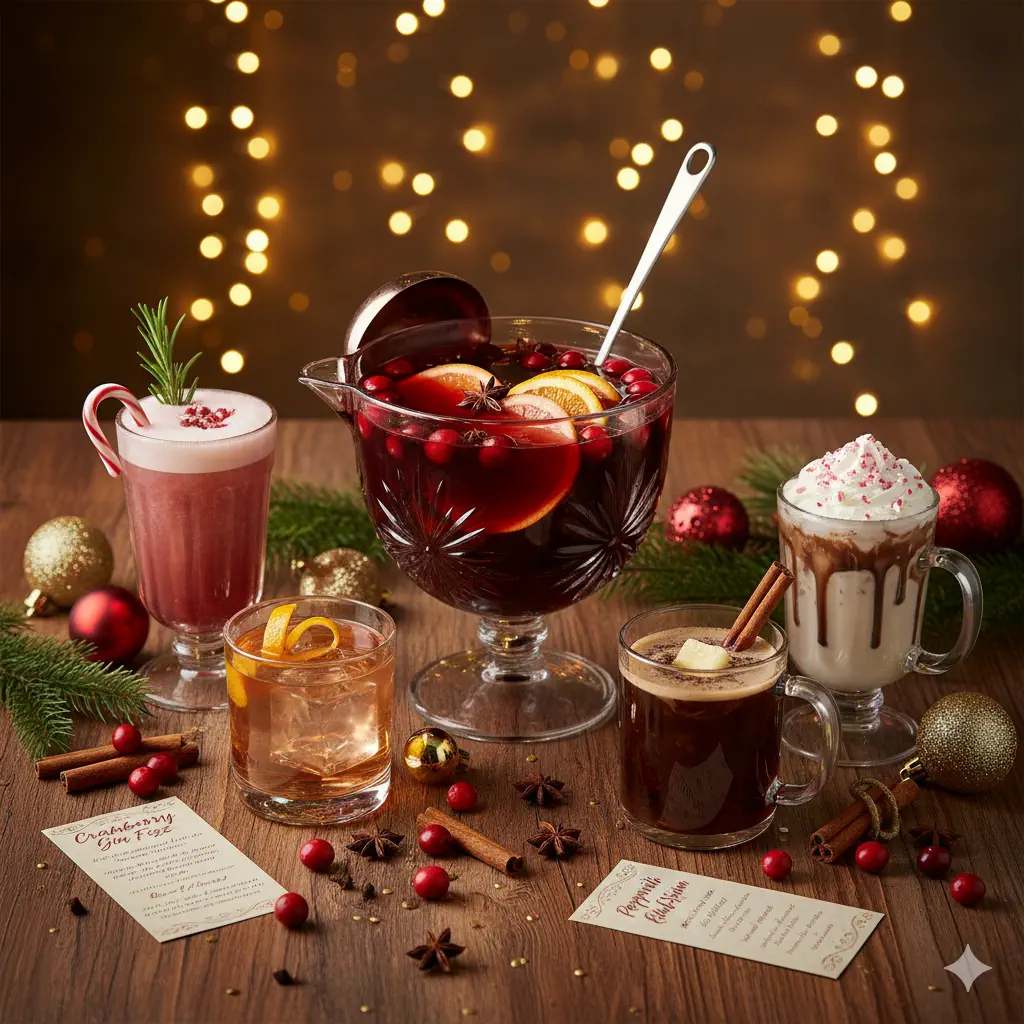
Festive Cocktails
Create signature Christmas cocktails that showcase seasonal flavors:
1. Cranberry Gin Fizz: Combine gin, fresh cranberry juice, a splash of lime, and top with soda water. Garnish with fresh cranberries and rosemary sprigs for a festive appearance. The bright acidity of cranberry balances the botanical notes of gin, while the bubbles make this a refreshing option between heavier drinks. Consider using a locally produced gin with strong juniper notes to complement the forest-inspired garnish.
2. Peppermint White Russian: Add a peppermint twist to the classic White Russian with a splash of peppermint schnapps or peppermint syrup. The combination of coffee liqueur, cream, and peppermint creates a dessert-like cocktail that captures the flavor of holiday candy. Garnish with crushed candy canes on the rim or a small candy cane stirrer for visual appeal.
3. Spiced Apple Old Fashioned: Infuse a traditional Old Fashioned with apple cider and cinnamon for a seasonal twist. The caramel notes of bourbon work beautifully with apple and warming spices, creating a sophisticated cocktail that appeals to whiskey lovers and newcomers alike. Using a good bourbon and freshly pressed cider makes this drink special.
Premium Spirits
Include a selection of quality spirits that are perfect for sipping during the winter months:
1. Aged Whiskey or Bourbon: The warm, caramel notes of aged whiskeys pair beautifully with the rich flavors of holiday foods. Consider offering a small tasting of different ages from the same distillery to show how aging affects flavor. You could also feature whiskeys finished in different casks (sherry, port, or rum) to demonstrate how these secondary aging processes add unique characteristics.
2. Spiced Rum: A quality spiced rum can be served neat or as the base for numerous holiday cocktails. Look for artisanal versions that use real spices rather than artificial flavorings. The vanilla, cinnamon, and clove notes in spiced rum naturally complement holiday desserts and can stand alone as an after-dinner drink.
3. Flavored Liqueurs: Consider orange, coffee, or chocolate liqueurs that can be enjoyed alone or added to hot beverages. These sweet, concentrated spirits add complexity to simple drinks and can transform ordinary coffee or hot chocolate into festive treats. Many traditional European liqueurs have centuries of history behind them and interesting stories to share with your guests.
Non-Alcoholic Options
Always include thoughtful non-alcoholic options that go beyond the typical sodas:
1. Spiced Hot Chocolate: Make hot chocolate special with cinnamon, cardamom, and a touch of chili for a complex, warming drink. Using high-quality chocolate (70% cocoa or higher) creates depth of flavor that rivals alcoholic options. Offer various toppings like whipped cream, marshmallows, or shaved chocolate to allow for personalization.
2. Sparkling Cranberry Punch: Combine cranberry juice, sparkling water, and fresh fruit for a festive mocktail. Adding a splash of apple cider vinegar or a squeeze of lime provides complexity and balance to the sweetness. Serve in champagne flutes with frozen cranberries as ice cubes for an elegant presentation.
3. Alcohol-Free Mulled Cider: Apple cider simmered with holiday spices provides a comforting option without alcohol. The natural sweetness of fresh cider gets stronger during simmering, while whole spices infuse the beverage with warming flavors. This option provides the wonderful aromas of traditional mulled beverages without the alcohol.
When selecting your beverages, consider the flow of the tasting. Generally, it’s best to progress from lighter to stronger flavors, allowing guests to appreciate the subtleties of each drink without palate fatigue. Begin with sparkling or lighter options, move through medium-bodied choices, and finish with the most robust flavors. Label each beverage clearly and provide information about its ingredients, flavor profile, and any interesting history or traditions associated with it to enhance the educational aspect of your tasting.
4. Christmas Food Pairings: Complementing Your Festive Drinks
No Christmas drink tasting is complete without thoughtfully selected food pairings. The right food can enhance the flavors of your beverages while providing sustenance throughout the tasting. When planning your pairings, consider both complementary and contrasting flavors that highlight the unique characteristics of each drink while creating a cohesive culinary experience that celebrates the holiday season.
Cheese and Charcuterie Boards
A well-curated cheese and charcuterie board is versatile enough to pair with multiple beverages:
1. For mulled wine and red wines: Aged cheeses like Gouda, Cheddar, or Manchego, paired with dried fruits like figs and apricots. The saltiness and umami of aged cheese balances the sweetness and spice of mulled wine, while dried fruits echo and enhance the fruity notes in the beverage. Consider adding candied nuts with warming spices to bridge the flavor profiles of the food and drink.
2. For craft beers: Smoked meats, sharp cheeses, and whole grain mustards. The maltiness of winter ales pairs beautifully with the savory richness of smoked sausages or ham. Sharp cheeses cut through the heaviness of dark beers, while spicy mustards complement the hoppy bitterness found in some seasonal brews. Include pretzel bread or hearty crackers to complete this rustic pairing.
3. For spirits: Blue cheese, aged hard cheeses, and dark chocolate. The intense flavors of blue cheese stand up to the robustness of aged spirits like whiskey or bourbon. The slight sweetness of aged hard cheeses like aged Gouda complements the caramel notes in many spirits, while high-quality dark chocolate enhances the complexity of both rum and whiskey with complementary bitter and sweet notes.
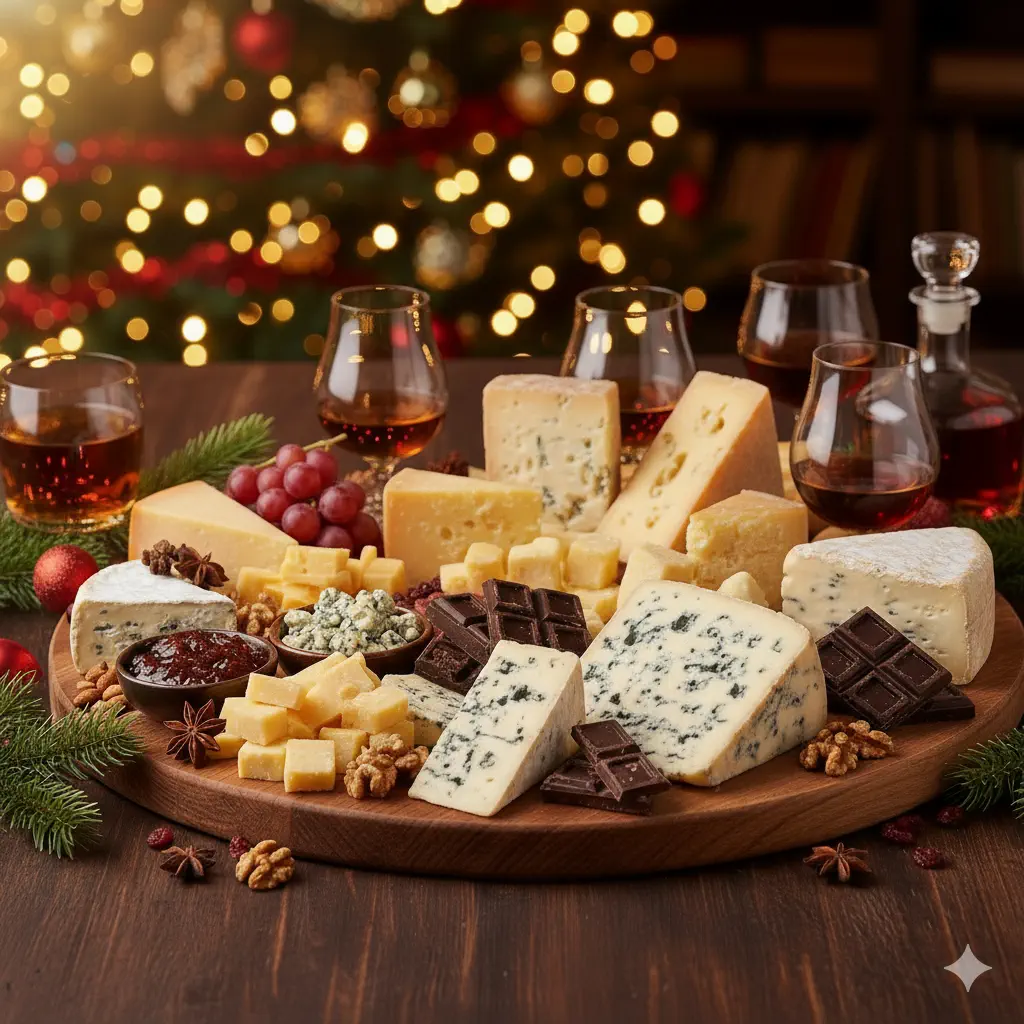
Festive Appetizers
Small, flavorful bites are perfect for a tasting event:
1. Cranberry and brie bites: The creamy cheese and tart cranberry complement both wine and cocktails. Serve these warm in phyllo cups or on crostini for an elegant presentation. The combination of creamy, tangy, and slightly sweet flavors works particularly well with both sparkling wines and spiced cocktails, making this a versatile pairing for multiple beverages in your tasting.
2. Spiced nuts: Roasted nuts with cinnamon, rosemary, and a touch of cayenne pair wonderfully with aged spirits and winter beers. The warming spices echo those found in many holiday beverages, while the protein and fat content help mitigate alcohol absorption. Consider a mixture of pecans, walnuts, and almonds for textural variety and different flavor affinities with various drinks.
3. Smoked salmon crostini: These light bites work well with sparkling wines and lighter cocktails. Top with a small dollop of crème fraîche and fresh dill for a classic combination. The richness of the salmon provides substance without overwhelming delicate beverages, while the acidity in many lighter drinks cuts through the fattiness of the fish for a balanced experience.
4. Mini meatballs with cranberry glaze: The savory-sweet combination pairs nicely with bold red wines and dark beers. Using festive spices like nutmeg, allspice, and cinnamon in both the meatballs and glaze creates a cohesive flavor profile that bridges food and beverage. These substantial bites help ensure guests have adequate food when sampling multiple alcoholic beverages.
Sweet Treats
Include some holiday-inspired sweet options:
1. Dark chocolate truffles: Perfect with red wine, bourbon, or coffee-flavored liqueurs. Consider infusing the ganache with complementary flavors like orange zest, cinnamon, or even a touch of sea salt to create more complex pairings. The bittersweet nature of dark chocolate harmonizes with the tannins in red wine and the caramel notes in aged spirits.
2. Gingerbread cookies: The spicy notes complement mulled wine and spiced cider beautifully. Traditional German or Scandinavian recipes often include black pepper, cardamom, and cloves—spices that directly echo those found in mulled beverages. The sweetness of the cookies balances any bitterness in the drinks, while the spices create a harmonious flavor bridge.
3. Mini fruit tarts: These lighter desserts pair well with sweeter cocktails and sparkling wines. Seasonal fruits like cranberries, pears, or preserved summer berries provide acidity that balances sweet beverages. The buttery pastry adds richness without overwhelming more delicate drink options, making these versatile pairings for multiple beverages.
4. Peppermint bark: The combination of chocolate and mint works wonderfully with hot chocolate and creamy cocktails. The refreshing quality of peppermint provides a palate-cleansing effect between tastings, while the chocolate components complement the richness of cream-based drinks. These can be broken into small pieces for easy sampling throughout the event.
Creating Balanced Pairings
When planning your food offerings, aim for a balance of flavors and textures:
1. Contrast rich drinks with acidic or fresh foods (like citrus-based appetizers with creamy eggnog). This contrast prevents palate fatigue and highlights different aspects of both the food and beverage. For example, a bright citrus salad can cut through the richness of eggnog, allowing guests to appreciate its complexity without feeling overwhelmed by its heaviness.
2. Complement spiced beverages with similarly spiced foods (like gingerbread with mulled wine). When flavors echo each other, they create a harmonious experience that enhances both components. The cinnamon, clove, and nutmeg in gingerbread reinforce these same notes in mulled wine, creating a more pronounced and satisfying flavor experience.
3. Balance alcohol strength with food richness (stronger drinks pair well with fattier, more substantial foods). Higher alcohol content beverages need foods with protein and fat to moderate their impact. This is both a flavor consideration and a responsible hosting practice, as substantial foods help slow alcohol absorption and keep guests comfortable throughout a multi-beverage tasting.
4. Consider texture contrasts (crispy appetizers with smooth, creamy drinks). Textural variety keeps the palate engaged and creates more memorable pairings. A crisp phyllo pastry or crunchy crostini provides delightful contrast to creamy cocktails or smooth spirits, creating a more dynamic eating and drinking experience.
Perfect Christmas Drink and Food Pairings
| Beverage | Ideal Food Pairing | Why It Works |
|---|---|---|
| Mulled Wine | Aged Gouda, Gingerbread | The spices in both complement each other |
| Eggnog | Shortbread Cookies, Nutmeg-dusted Cheese | The buttery, creamy notes harmonize |
| Winter Ale | Smoked Meats, Sharp Cheddar | The maltiness of the beer complements savory foods |
| Cranberry Cocktails | Brie, Turkey Canapés | Tart cranberry cuts through rich, creamy flavors |
| Aged Bourbon | Dark Chocolate, Pecans | The caramel notes in bourbon enhance the chocolate |
Be sure to label all food items clearly, especially noting any common allergens like nuts, dairy, or gluten. Consider creating small cards that suggest specific pairings for each beverage to guide guests through the tasting experience. This educational component adds value to your event and helps guests discover combinations they might not have tried otherwise. Remember to provide serving utensils for each item and plenty of small plates so guests can sample multiple pairings comfortably.
5. Conducting Your Christmas Tasting: A Step-by-Step Guide
With all your preparations in place, it’s time to focus on conducting a smooth and enjoyable tasting experience. A well-structured approach ensures that your guests get the most out of each beverage while maintaining a relaxed, festive atmosphere. The right balance of information, guidance, and free exploration creates a memorable event that feels both special and comfortable.
Welcoming Your Guests
Start by greeting guests with a welcome drink—something light and refreshing that won’t overwhelm the palate before the main tasting begins. A sparkling wine with a splash of cranberry juice or a light winter punch works well. This gives everyone something to sip while waiting for all guests to arrive and allows for a proper introduction to the event. Consider having this welcome beverage pre-poured and ready to hand to guests as they arrive, creating an immediate sense of hospitality and setting a festive tone.
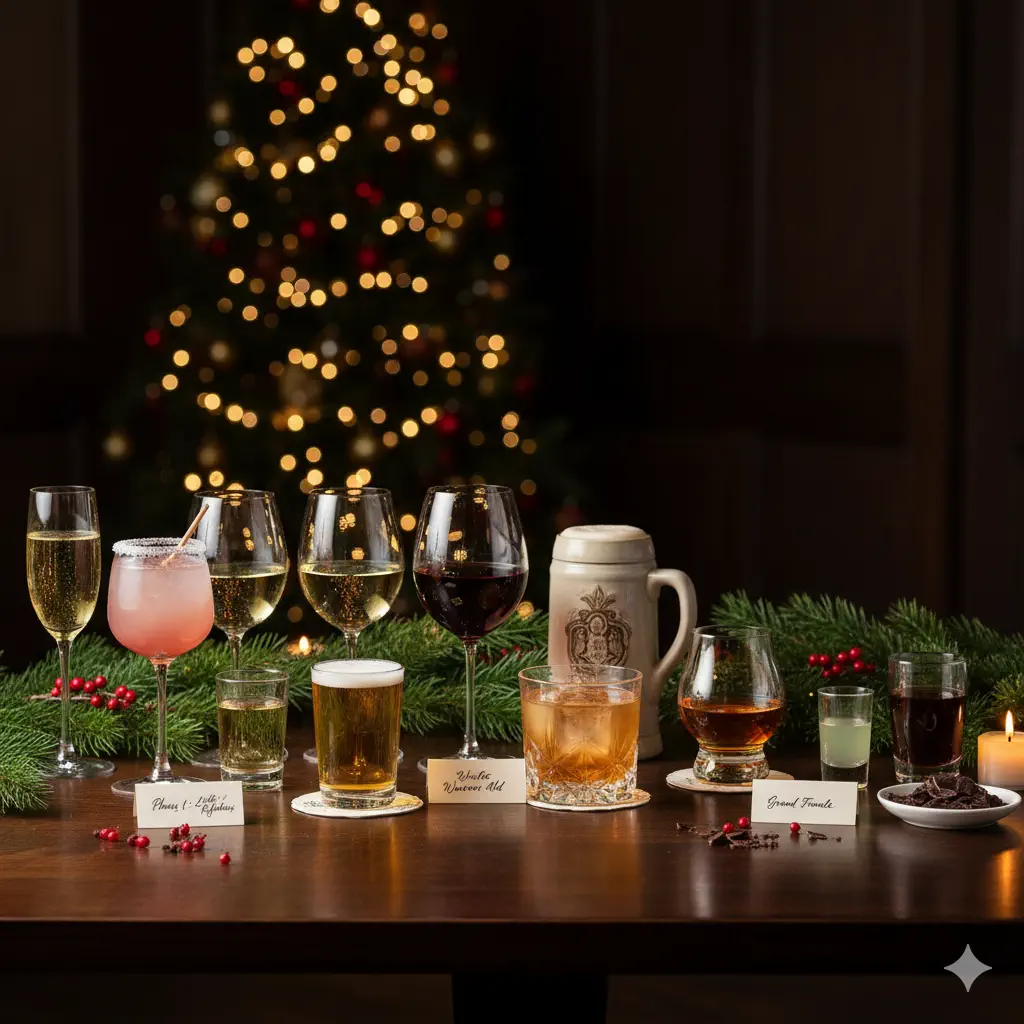
Introduction and Overview
Once all guests have arrived, gather everyone together for a brief introduction:
1. Welcome everyone and explain the format of the tasting, including how long it will last and what to expect.
2. Provide an overview of the beverages they’ll be sampling, mentioning any special or unique selections you’re particularly excited to share.
3. Explain any tasting techniques you’ll be using, such as the proper way to evaluate aroma or how temperature affects flavor perception.
4. Point out the location of water, palate cleansers, and spittoons, emphasizing that using these is encouraged and expected at a proper tasting.
5. Mention food pairings and when they’ll be served, highlighting any particularly interesting combinations you’ve planned.
Tasting Structure
For a structured yet relaxed experience, follow these steps:
1. Progress in a logical order: Start with lighter beverages and move to stronger ones. For example:
- Begin with sparkling wines or light cocktails that refresh and stimulate the palate
- Move to white wines or lighter beers with subtle complexity that builds on the first round
- Progress to red wines and fuller-bodied beers with more pronounced flavors
- Continue with spirit-forward cocktails that introduce higher alcohol content
- Finish with neat spirits and dessert wines that provide a satisfying conclusion
2. Introduce each beverage: Before serving each drink, share information about:
- Its name and origin, including any interesting historical context
- Main ingredients and production method, highlighting traditional techniques
- Flavor profile and what to look for, giving guests specific notes to identify
- Any Christmas traditions or history associated with it, connecting the beverage to holiday celebrations
- Suggested food pairings, explaining why certain combinations work particularly well
3. Guide the tasting process: For each beverage, lead guests through:
- Observing appearance (color, clarity, bubbles if applicable) by holding glasses against light or white backgrounds
- Smelling the aroma (swirling if appropriate) with different techniques for different beverages
- Tasting, noting initial flavors, mid-palate, and finish, and how these change with repeated sips
- Discussing impressions and reactions, encouraging guests to share their observations
4. Encourage interaction: After each tasting, allow time for:
- Questions about the beverage, its production, or its history
- Sharing of personal impressions, validating different taste experiences
- Discussion of food pairings and how they enhance or contrast with the beverage
- Comparing to previously tasted beverages to notice progression and differences
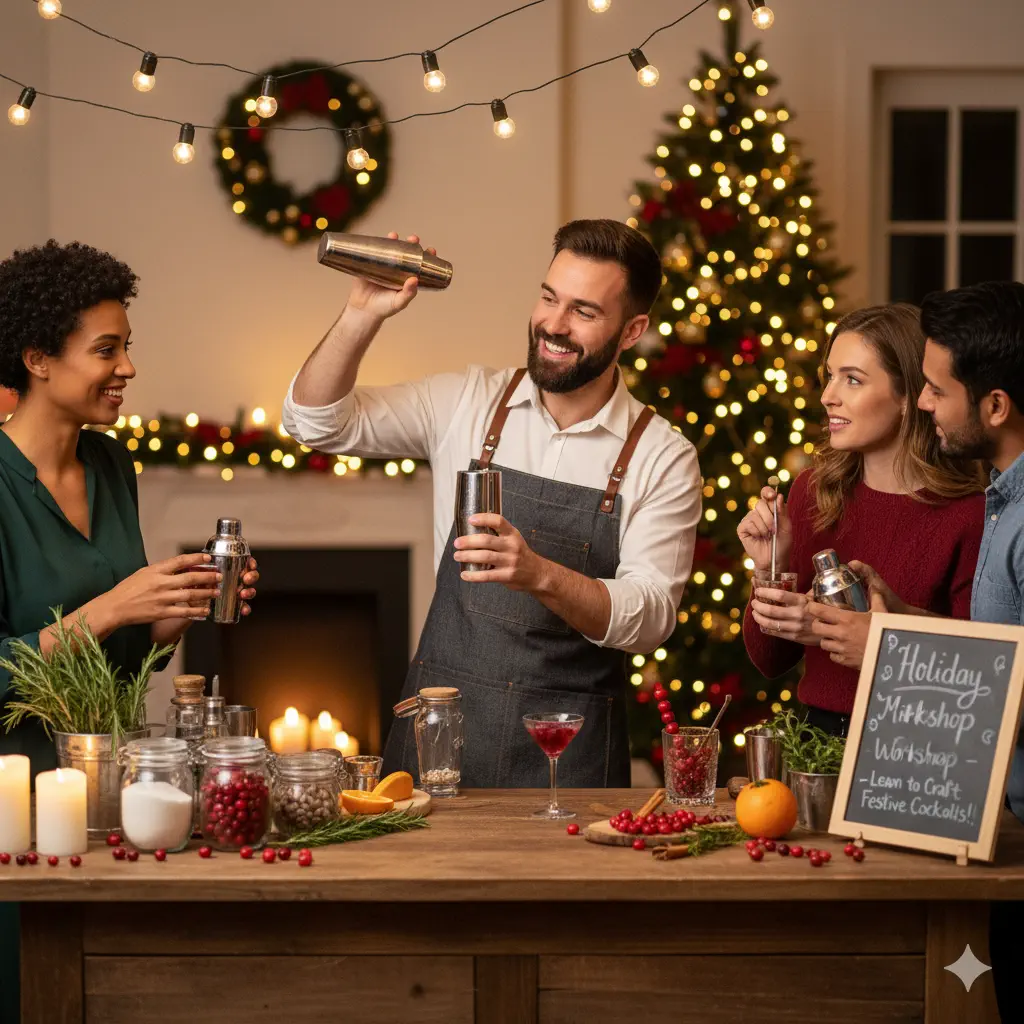
Christmas Drink Tasting Flow
Welcome Drink
Cranberry Fizz
Light & Refreshing
First Round
Sparkling Wine
With cheese canapés
Second Round
Winter Ale
With spiced nuts
Third Round
Mulled Wine
With gingerbread
Final Round
Aged Spirits
With dark chocolate
Pace and Timing
Keep the tasting moving at a comfortable pace:
1. Allow about 10-15 minutes for each beverage, including introduction, tasting, and discussion. This provides enough time for thoughtful appreciation without dragging the experience.
2. Include short breaks between categories of beverages, allowing guests to refresh their palates, socialize freely, and enjoy food pairings more casually.
3. Be flexible—if a particular drink sparks engaging conversation, don’t rush to move on. The social aspect is as important as the tasting itself.
4. Pay attention to your guests’ energy levels and adjust timing accordingly. If attention is waning, consider moving more quickly through remaining beverages or taking a longer break.
Managing the Experience
Throughout the tasting, be attentive to your guests’ needs:
1. Ensure everyone has access to water and palate cleansers between tastings. Neutral crackers, sliced apples, or cucumber can help reset the palate.
2. Monitor consumption and be prepared to serve smaller portions if needed. Remember that a tasting is about quality appreciation, not quantity consumption.
3. Check that food pairings are readily available throughout the event, replenishing as necessary to ensure everyone has access to substantive food.
4. Be mindful of guests who may be approaching their limits and tactfully offer non-alcoholic alternatives. Having beautiful, complex non-alcoholic options makes this transition graceful rather than awkward.
Remember that the goal is to create an enjoyable, educational experience rather than simply consuming beverages. Encourage mindful tasting and appreciation of flavors rather than quantity. A successful tasting leaves guests feeling they’ve learned something new about holiday beverages while enjoying a sophisticated social experience. Balance structured guidance with free-flowing conversation and opportunities for guests to explore at their own pace.
6. Christmas Cocktail Demonstrations: Interactive Elements
Adding an interactive element to your Christmas drink tasting can elevate the experience from a passive sampling to an engaging activity. Cocktail demonstrations are perfect for this purpose, allowing guests to learn new skills while personalizing their drinks to their preferences. This hands-on component creates memorable moments and gives guests practical knowledge they can use for their own holiday entertaining.
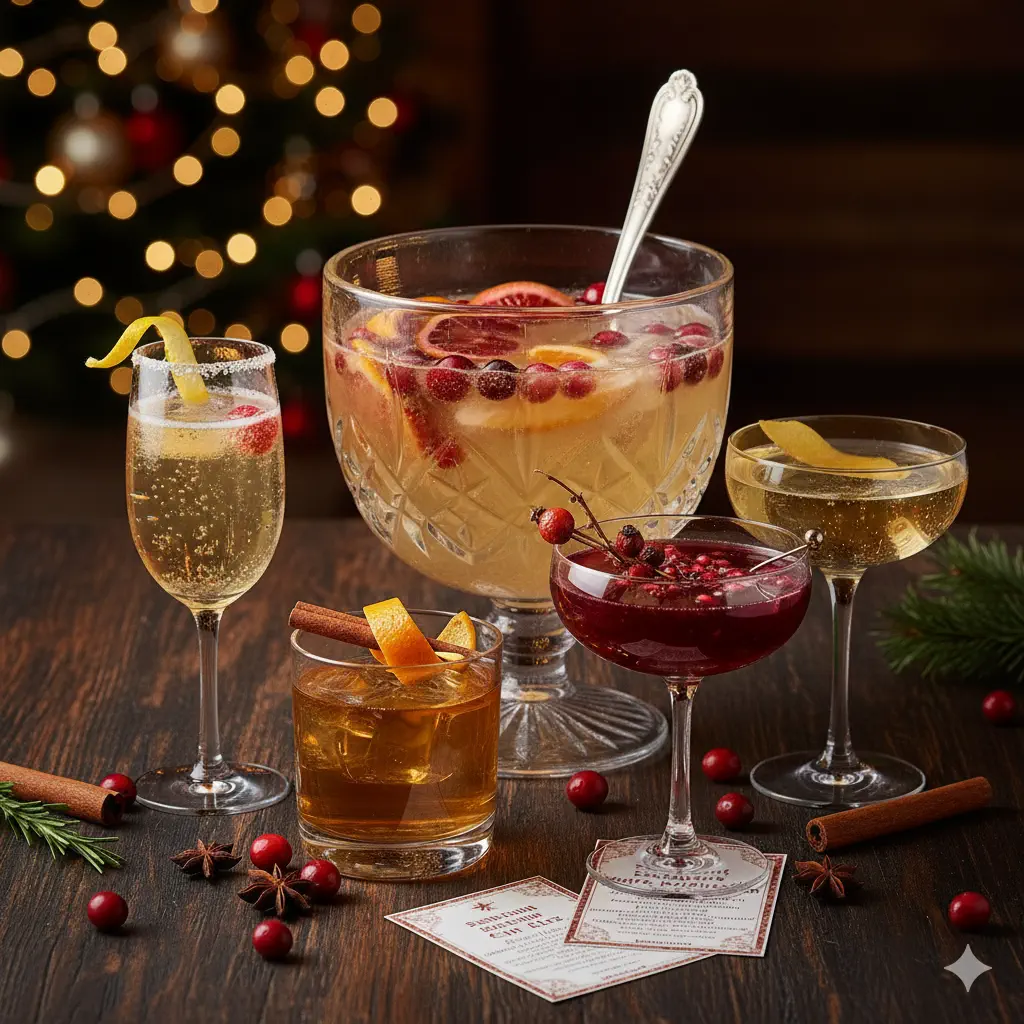
Setting Up a Demonstration Station
Create a dedicated area for cocktail demonstrations with:
1. A clear workspace visible to all guests, possibly elevated or positioned so everyone can see the preparation techniques
2. Pre-measured ingredients in attractive containers, using glass bottles, mason jars, or decorative dispensers for visual appeal
3. All necessary tools (shakers, strainers, jiggers, bar spoons, muddlers) arranged neatly and within easy reach
4. Recipe cards for guests to take home, designed with festive elements that complement your overall decor
5. Festive garnishes arranged attractively on small platters or in compartmentalized containers
Choosing Demonstration-Worthy Cocktails
Select 2-3 cocktails that:
1. Feature seasonal ingredients and flavors that capture the essence of Christmas, such as cranberry, cinnamon, peppermint, or orange
2. Showcase different techniques (shaking, stirring, building, muddling) to provide variety and educational value
3. Can be easily recreated at home with ingredients and equipment accessible to most people
4. Have visual appeal during preparation, with color changes, layering, or dramatic garnishing
Some Christmas cocktail suggestions for demonstrations:
1. Cranberry Rosemary Gin Fizz
- Gin, fresh cranberry juice, rosemary simple syrup, lemon juice, topped with soda
- Techniques: Muddling cranberries to release their color and flavor, shaking with ice to properly dilute and chill, garnishing with frosted cranberries and rosemary sprigs
- Visual elements: The vibrant red color, the aromatic release when muddling rosemary, the effervescence when adding soda
2. Spiced Old Fashioned
- Bourbon, cinnamon-infused simple syrup, bitters, orange peel
- Techniques: Stirring to proper dilution without over-aeration, expressing oils from citrus peel, proper ice usage and selection
- Visual elements: The amber color deepening as dilution occurs, the spray of citrus oils across the surface, the gradual melting of a large ice cube
3. Peppermint White Christmas
- White chocolate liqueur, peppermint schnapps, cream, vanilla vodka
- Techniques: Layering ingredients for visual effect, rimming glasses with crushed candy canes, proper temperature control for cream-based drinks
- Visual elements: The striking white color, the contrast of red candy cane rim, optional floating mint leaf garnish
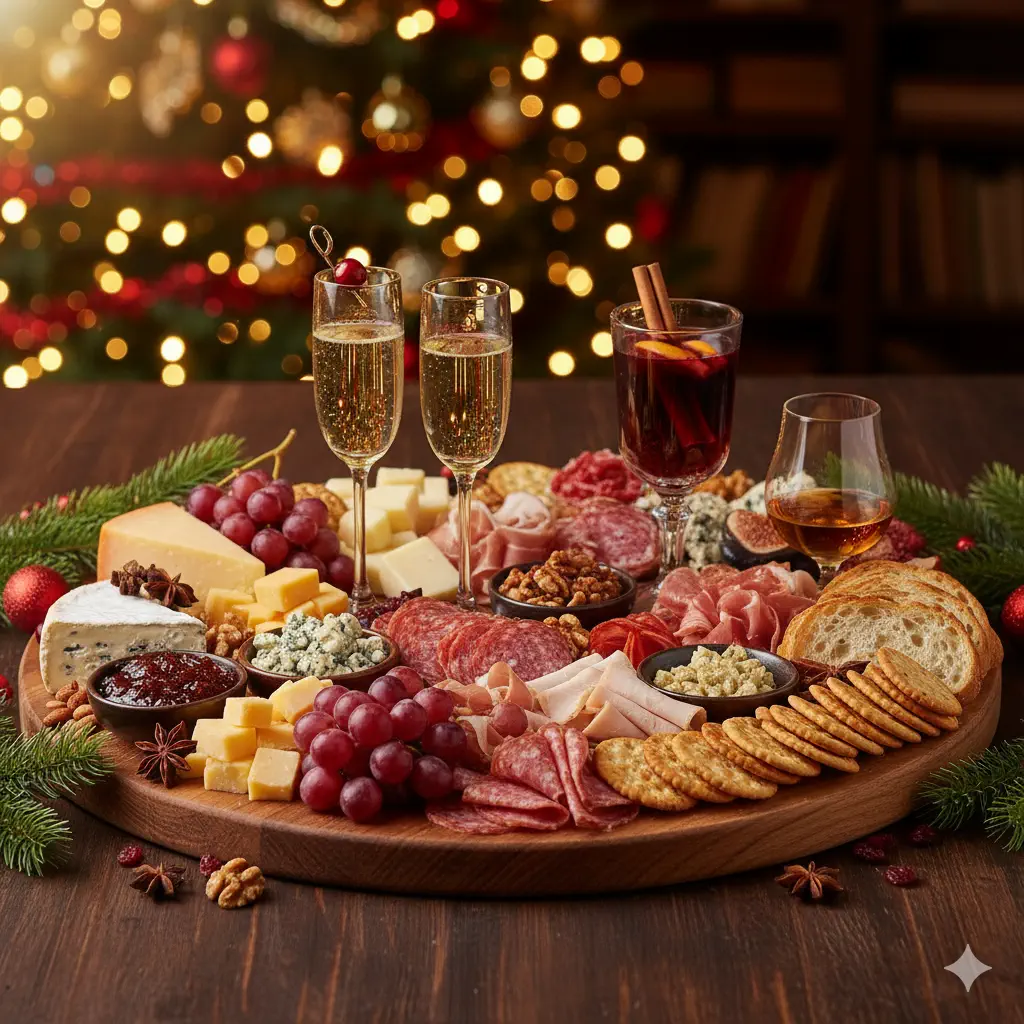
Conducting the Demonstration
For each cocktail demonstration:
1. Begin by explaining the history or inspiration behind the drink, connecting it to Christmas traditions or winter flavors
2. Introduce the ingredients and their flavor contributions, noting any special brands or varieties you’ve selected
3. Demonstrate techniques step by step, explaining the purpose of each (why we shake versus stir, how muddling releases essential oils, etc.)
4. Share tips for variations or substitutions, accommodating different taste preferences or ingredient availability
5. Allow guests to sample the finished product, encouraging them to note how the flavors combine and evolve
6. Invite questions throughout the process, creating an interactive rather than presentational atmosphere
Hands-On Participation
For a truly interactive experience, consider:
1. Inviting guests to create their own version after watching your demonstration, either individually or in small groups
2. Setting up mini-stations with pre-measured ingredients to streamline the process and prevent spillage or waste
3. Providing recipe variations for guests to experiment with (spicier, sweeter, stronger, or milder versions)
4. Hosting a friendly competition for the most creative or delicious variation, with a small prize for the winner
Christmas Cocktail Recipe Card: Cranberry Rosemary Gin Fizz
Ingredients:
- 2 oz gin
- 1 oz fresh cranberry juice
- ½ oz rosemary simple syrup
- ½ oz fresh lemon juice
- Soda water to top
- Fresh cranberries and rosemary sprig for garnish
Instructions:
- Muddle 5-6 cranberries in a shaker
- Add gin, cranberry juice, rosemary syrup, and lemon juice
- Add ice and shake vigorously for 15 seconds
- Double strain into an ice-filled glass
- Top with soda water
- Garnish with frosted cranberries and rosemary sprig
Tips for Successful Demonstrations
1. Practice beforehand: Ensure you can make each cocktail smoothly and confidently without referring to recipes or fumbling with techniques. A rehearsed demonstration flows better and instills confidence in your guests.
2. Prepare extra ingredients: Have backups in case of spills or mistakes, particularly for key components that might be limited, like fresh juices or special syrups.
3. Keep explanations clear and concise: Focus on key techniques rather than overwhelming with details. Remember that guests are there to enjoy themselves, not attend a professional bartending course.
4. Consider visibility: Ensure all guests can see what you’re doing, possibly using a mirror above the workspace or demonstrating at a higher counter. For larger
Printable Recipe Card
Want just the essential recipe details without scrolling through the article? Get our printable recipe card with just the ingredients and instructions.

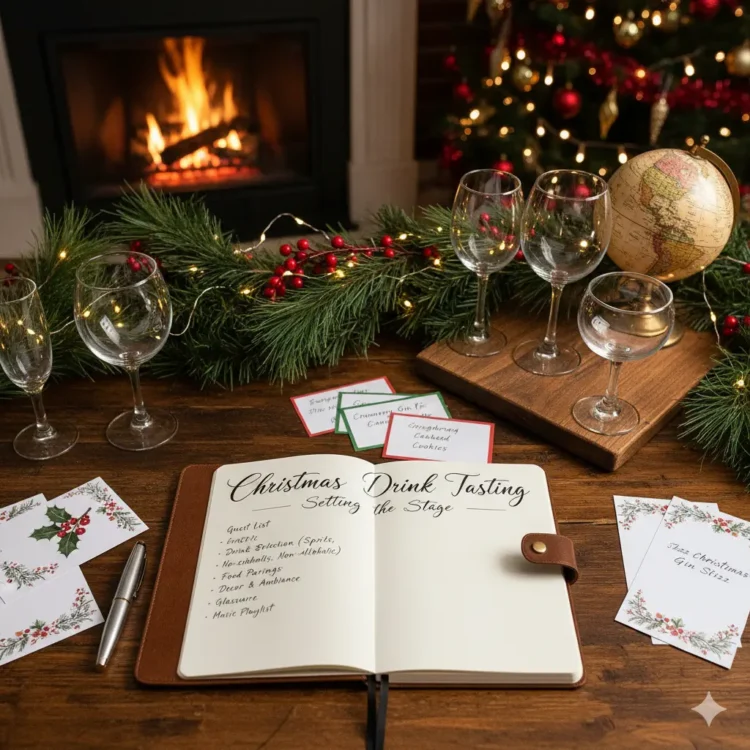
Pingback: 12 Unique Traditional Thanksgiving Desserts with a Twist - Whaley Cooks
Pingback: Sustainable Thanksgiving Practices: A Memorable Guide to Eco-Friendly Celebrations - Whaley Cooks